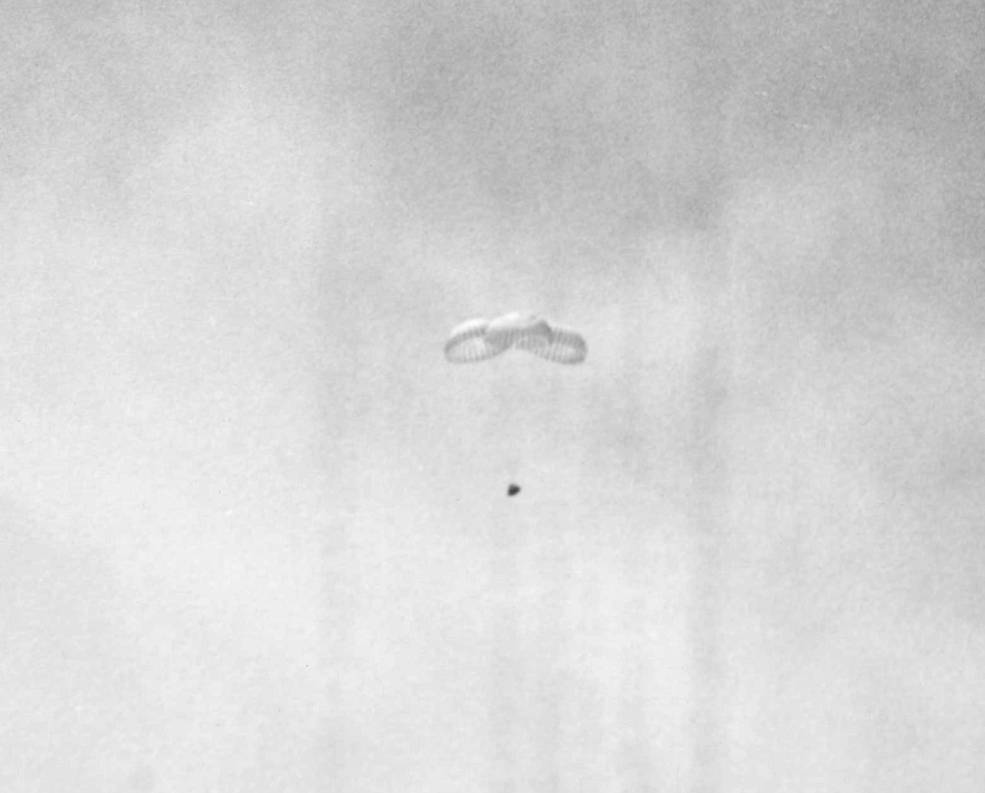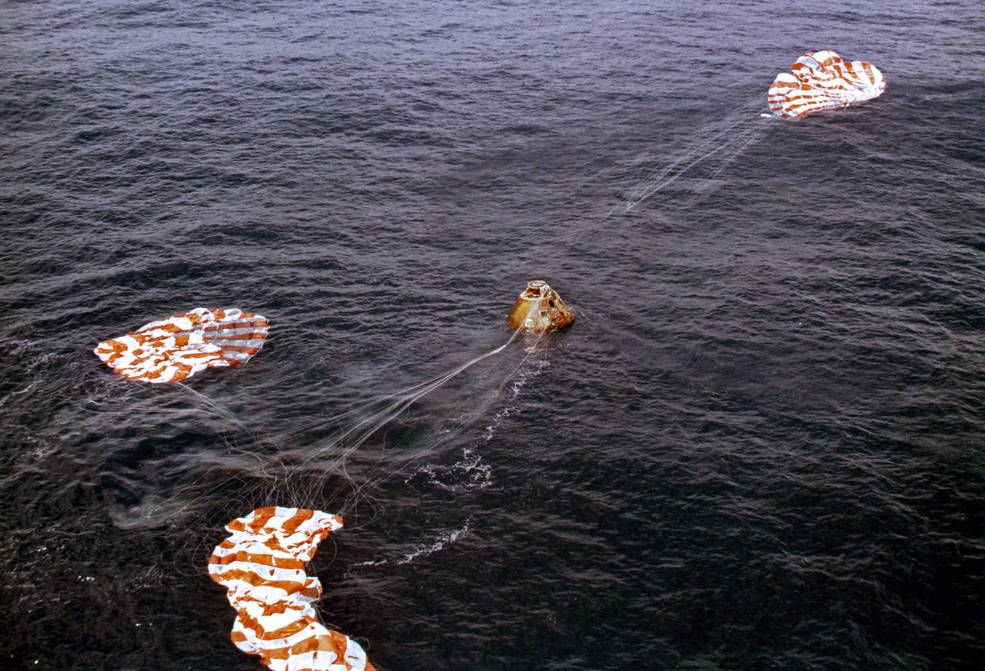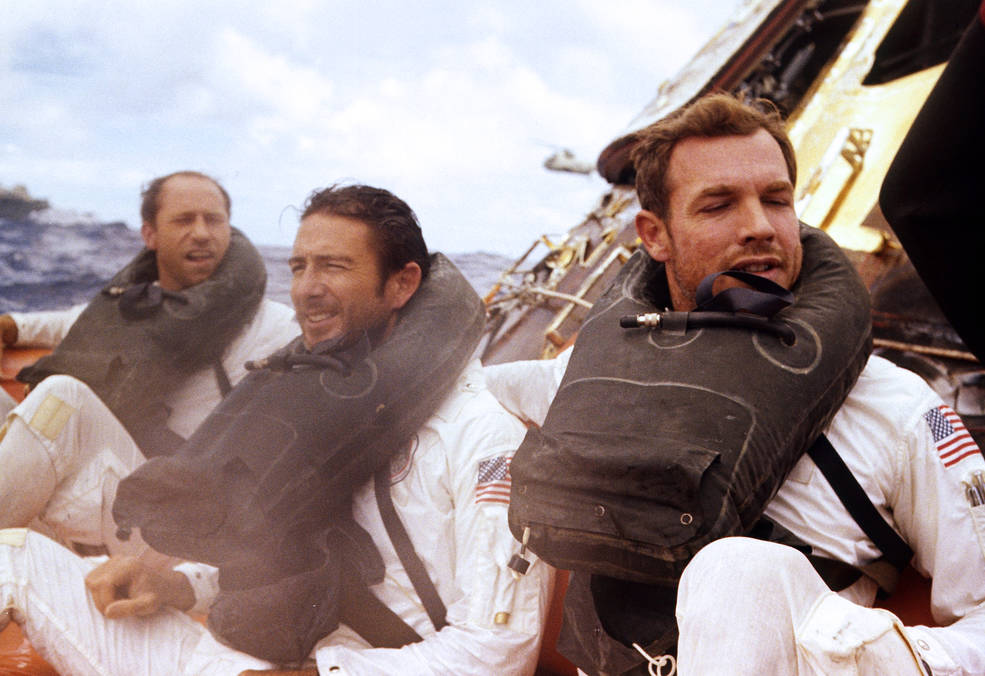On Aug. 7, 1971, Apollo 15 astronauts David R. Scott, Alfred M. Worden and James B. Irwin ended their successful 12-day Moon landing mission with a splashdown in their Command Module (CM) Endeavour in the Pacific Ocean. One of the three main parachutes collapsed during the descent, but did not harm the astronauts. Recovery forces from the U.S.S. Okinawa monitored the descent and landing and retrieved the astronauts and their spacecraft. Scott, Worden, and Irwin were the first Moon landing crew not required to undergo the three-week postflight quarantine. Officials from NASA, the U.S. Navy, and the U.S. Air Force greeted the astronauts as they stepped off the recovery helicopter. They spent their first night on Earth aboard Okinawa before beginning the journey home to Houston.
When Scott, Worden, and Irwin awoke after their last night’s sleep in space, Endeavour had closed the distance to Earth to 62,000 miles and their velocity continued to increase. In the Mission Control Center at the Manned Spacecraft Center (MSC), now NASA’s Johnson Space Center in Houston, Flight Director Milton L. Windler and his Maroon Team of controllers, including capsule communicator (capcom) Joseph P. Allen monitored the mission from their consoles during the crew’s sleep and early morning. Allen played a Hawaiian War Chant by Hawaiian musician Al Kealoha Perry as the wakeup music, rousing the astronauts from their sleep. Out the spacecraft’s windows, the relative size of the Earth had increased but the visible portion had shrunk to a thin crescent with only about 10 percent of the planet illuminated from the astronauts’ perspective. Flight Director Eugene F. “Gene” Kranz and his White Team, including capcom Robert A.R. Parker took over the consoles in Mission Control to see the crew through to splashdown. In preparation for reentry and landing, the astronauts shut down the instruments in the Scientific Instrument Module (SIM) bay for the final time.


Left: Photograph of the thin crescent Earth taken by Apollo 15 astronauts from about 40,000 miles during their return trip. Right: Still image from a film taken from a Command Module window during reentry showing the trail of ionized gas on the left and the Earth on the right.
The major task of the morning involved performing a minor course correction using the Service Module’s Reaction Control System thrusters to slightly tweak their spacecraft’s trajectory for reentry and lead to a splashdown point closer to the intended target point. The 22-second burn took place when Apollo 15 was 29,000 miles from Earth. The astronauts powered up the CM’s reaction control system thrusters to prepare it for its solo entry through the atmosphere and separated from the Service Module at an altitude of a little more than 3,000 miles. They maneuvered Endeavour so its heat shield faced in the direction of flight and experienced the upper layers of Earth’s atmosphere at about 400,000 feet, the point known as entry interface, at a velocity of 24,580 miles per hour. The spacecraft’s motion compressed the molecules of the thin air to create a sheath of plasma around the capsule, blocking out communications for about three and a half minutes. The astronauts briefly experienced a force of about 6.2 Gs due to the rapid deceleration.


Two images taken from a recovery helicopter of the Apollo Command Module Endeavour during its descent, showing all three main parachutes inflated, left, followed shortly by the collapse of one of the main parachutes.


Left: Apollo 15 Command Module Endeavour descending on two main parachutes after the third parachute collapsed. Right: The moment of the Apollo 15 splashdown.
Following the radio blackout, Endeavour jettisoned its forward heat shield, also known as the apex cover, at 24,000 feet to enable first the two drogue parachutes to deploy to help stabilize and slow the spacecraft to 170 miles per hour. At 10,000 feet, the three 83-foot-wide main parachutes deployed. At approximately 6,000 feet, one of the main parachutes collapsed, most likely caused by remaining fuel being dumped overboard damaging the parachute’s risers and suspension lines. The Apollo landing system was designed to achieve a safe landing with only two parachutes, the third adding an extra margin of safety. As a result of the one parachute’s collapse, Apollo 15 splashed down at 22 miles per hour instead of the expected 19 miles per hour and the astronauts were not harmed in any way. The splashdown point 330 miles north of Honolulu was 1 mile from the target and about 6 miles from the prime recovery ship U.S.S. Okinawa (LPH-3). The mission duration of 12 days, 7 hours, and 12 minutes marked the longest Apollo mission to that time.



Left: Apollo 15 Command Module Endeavour moments after splashdown, with the three parachutes in the water. Middle: Apollo 15 astronauts Alfred M. Worden, left, James B. Irwin, and David R. Scott in the recovery life raft after exiting their spacecraft. Right: Image taken by one of the recovery swimmers of Apollo 15 astronauts Worden, left, Irwin, and Scott in the recovery life raft.

Mission Control following the Apollo 15 splashdown.


Left: Robert R. Gilruth, right, director of the Manned Spacecraft Center, now NASA’s Johnson Space Center in Houston, greets Apollo 15 astronauts Alfred M. Worden, left, James B. Irwin, and David R. Scott as they step off the recovery helicopter onto the deck of the prime recovery ship U.S.S. Okinawa. Right: At the welcome ceremony on the U.S.S. Okinawa, General Lucius D. Clay, left, Commander of the United States Air Force, Scott, Brigadier General Frank K. Everest, Commander of the U.S Air Force Aerospace Rescue and Recovery Service, Worden, Irwin, and Rear Admiral Thomas B. Hayward, Commander of Task Force 130, Pacific Recovery Area.
Recovery of the Apollo 15 astronauts following splashdown was simpler than on previous Moon landing missions, as NASA had decided to eliminate the postflight quarantine designed to prevent back contamination of the Earth with possible lunar microorganisms. Evidence from Apollo 11, 12, and 14 clearly indicated that the Moon was devoid of any life. Within 39 minutes, aided by swimmers from Task Force 130, Pacific Recovery Area, Scott, Worden, and Irwin had exited Endeavour onto a life raft, were lifted aboard a recovery helicopter, and transported to Okinawa’s flight deck. On the ship, they were greeted by the ship’s commanding officer Captain Andrew F. Huff, MSC Director Robert R. Gilruth, U.S. Navy and U.S. Air Force officials, and hundreds of cheering sailors. In Mission Control, the room filled with not only the flight controllers, but many VIPs, and the customary cigars were lit as soon as Scott, Worden, and Irwin emerged from the recovery helicopter and stepped onto the ship’s deck. Sailors retrieved Endeavour onto Okinawa’s flight deck 55 minutes after the crew. The astronauts spent their first night back on Earth aboard the recovery ship before beginning their trip back to Houston.


Left: The prime recovery ship U.S.S. Okinawa approached the Apollo 15 Command Module Endeavour following splashdown. Right: Sailors placing Endeavour aboard Okinawa.
Following the topside welcome reception, Scott, Worden, and Irwin received medical examinations, the doctors declaring them to be in excellent health following their journey to the Moon and back. The ship’s captain hosted a dinner in their honor, during which they thanked the recovery team for their excellent performance. The astronauts spent their first night back on Earth aboard the recovery ship before beginning their trip back to Houston.
To be continued…
John Uri
NASA Johnson Space Center
























